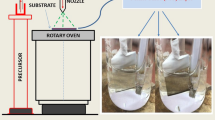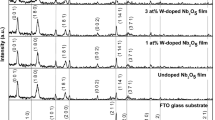Abstract
Al–B–NiO thin films were prepared using the sol–gel process and deposited on Indium tin oxide (ITO)-coated glass substrates via the dip-coating technique for the purpose of developing high performance electrochromic materials. The influence of the anneal on the structural and electrochromic properties of Al–B–NiO films is reported. Thermogravimetry (TG) and differential thermal analysis (DTA), cyclic voltammetry measurements (CV), UV spectrophotometer, atomic force microscopy (AFM) and X-ray diffraction (XRD) have been used to investigate the structural and electrochromic properties. The thickness of the films was determined by spectrophotometric analysis in 350–1,000 nm wavelength. Results showed that the Al–B–NiO thin films treated at high temperature have both the excellent electrochromic properties and good reversibility. The transmittance change (ΔT) of the film treated at 500 °C reaches still ~50% at the wavelength of 550 nm. The microstructure and the surface morphology were considered to play an important role in the electrochromic properties with different temperatures.






Similar content being viewed by others
References
Makhlouf SA, Parker FT, Spada FE, Berkowitz AE (1997) Magnetic anomalies in NiO nanoparticles. J Appl Phys 81:55–61
Shukla AK, Venugopalan S, Hariprakash B (2001) Nickel-based rechargeable batteries. J Power Sources 100:125–148
Ottaviano L, Pennisi A, Simone F (2004) Electrochromic nickel oxide films made by reactive r.f. sputtering from different targets. Surf Interface Anal 36:1335–1339
Christoskova SG, Danova N, Georgieva M, Argirov OK, Mehandzhiev D (1995) Investigation of a nickel oxide system for heterogeneous oxidation of organic compounds. Appl Catal A Gen 128:219–229
Avendaño E, Berggren L, Niklasson GA, Granqvist CG, Azens A (2006) Electrochromic materials and devices: brief survey and new data on optical absorption in tungsten oxide and nickel oxide films. Thin Solid Films 496:30–36
Lin SH, Chen FR, Kai JJ (2008) Electrochromic properties of nano-structured nickel oxide thin film prepared by spray pyrolysis method. Appl Surf Sci 254:2017–2022
Xia XH, Tu JP, Zhang J, Wang XL, Zhang WK, Huang H (2008) Electrochromic properties of porous NiO thin films prepared by a chemical bath deposition. Sol Energy Mater Sol Cells 92:628–633
Garcia-Miquel JL, Zhang Q, Allen SJ, Rougier A, Blyr A, Davies HO, Jones AC, Leedham TJ, Williams PA, Impey SA (2003) Nickel oxide sol–gel films from nickel diacetate for electrochromic applications. Thin Solid Films 424:165–170
Zayim EO, Turhan I, Tepehan FZ, Ozer N (2008) Sol-gel deposited nickel oxide films for electrochromic applications. Sol Energy Mater Sol Cells 92:164–169
Jiang SR, Feng BX, Yan PX, Cai XM, Lu SY (2001) The effect of annealing on the electrochromic properties of microcrystalline NiOx films prepared by reactive magnetron rf sputtering. Appl Surf Sci 174:125–131
Korosec RC, Bukovec P, Pihlar B, Vuk AS, Orel B, Drazic G (2003) Preparation and structural investigations of electrochromic nanosized NiOx films made via the sol-gel route. Solid State Ion 165:191–200
Korosec RC, Bukovec P, Pihlar B, Gomilsek JP (2003) The role of thermal analysis in optimization of the electrochromic effect of nickel oxide thin films prepared by the sol-gel method. Part I. Thermochim Acta 402:57–67
Korosec RC, Bukovec P (2004) The role of thermal analysis in optimization of the electrochromic effect of nickel oxide thin films prepared by the sol-gel method: Part II. Thermochim Acta 410:65–71
Lou X, Zhao X, Feng J, Zhou X (2009) Electrochromic properties of Al doped B-subsituted NiO films prepared by sol–gel. Prog Org Coatings 64:300–303
Yang LJ, Gao XP, Wu QD, Zhu HY, Pan GL (2007) Phase distribution and electrochemical properties of Al-substituted nickel hydroxides. J Phys Chem C 111:4164–4619
Sevim F, Demir F, Bilen M, Okur H (2006) Kinetic analysis of thermal decomposition of boric from thermogravimetric data. Korean J Chem Eng 23:736–740
Azároff LV (1968) Elements of X-ray crystallography. McGraw-Hill Book, New York
Lin C, Al-Muhtaseb SA, Ritter JA (2003) Thermal treatment of sol-gel derived nickel oxide xerogels. J Sol-Gel Sci Technol 28:133–141
Chen X, Hu X, Feng J (1995) Nanostructured nickel oxide films, their electrochromic properties. Nanostruct Mater 6:309–312
Qi JY, Xu P, Lv ZS, Liu XR, Wen AH (2008) Effect of crystallinity on the electrochemical performance of nanometer Al-stabilized α-nickel hydroxide. J Alloys Compd 462:164–169
Liu B, Yunshi Z, Yuan H, Yang H, Yong E (2000) Electrochemical studies of aluminum substituted α-Ni(OH)2 electrodes. Int J Hydrogen Energy 25:333–337
Jeong DJ, Kim W-S, Choi Y-K, Sung Y-E (2001) Intercalation/deintercalation characteristics of electrodeposited and anodized nickel thin film on ITO electrode in aqueous and nonaqueous electrolytes. J Electroanal Chem 511:79–87
Delmas C, Faure C, Borthomieu Y (1992) The effect of cobalt on the chemical and electrochemica behaviour of the nickel hydroxide electrode. Mater Sci Eng B 13:89–96
Granquist CG (2002) Handbook of inorganic electrochromic materials. Elsevier, Amsterdam
Acknowledgments
The author is grateful for helpful discussion from Mr. X.T. Sui. The author would like to thank the help of Suling Zhao for the atomic force measurements. This work was financial support by the Program for Changjiang Scholars and Innovative Research Team in University, Ministry of Education, China (PCSIRT, No. IRT0547).
Author information
Authors and Affiliations
Corresponding author
Rights and permissions
About this article
Cite this article
Lou, X.C., Zhao, X.J., Xiong, Y.L. et al. The influence of annealing on electrochromic properties of Al–B–NiO thin films prepared by sol–gel. J Sol-Gel Sci Technol 54, 43–48 (2010). https://doi.org/10.1007/s10971-010-2155-3
Received:
Accepted:
Published:
Issue Date:
DOI: https://doi.org/10.1007/s10971-010-2155-3




